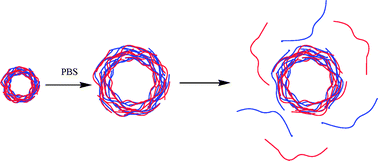Hydroxypropylcellulose (HPC), a cellulose derivative, and poly(acrylic acid) (PAA) were assembled onto colloidal SiO2 particles in acidic solutions in a layer-by-layer manner, using hydrogen bonding as the driving force. Monodisperse hollow microcapsules were prepared by the removal of the sacrificial template. Long-term stability of the hydrogen-bonded capsules under various conditions was studied with dynamic light scattering. In contrast to an expected quick response to pH change upon mixing with phosphate buffered saline (PBS), a slow swelling of the capsule wall was observed, which is attributed to the hydrophobicity and semi-rigidity of the HPC chains involved in the hydrogen-bonded capsule wall. Because of the reversible nature of hydrogen bonding, all HPC/PAA capsules eventually disintegrate completely regardless of pH of the media. High ionic strength slows down the swelling and disintegration of the capsule wall by effective screening of the repulsive interaction among the ionized groups, however, it cannot totally prevent the capsule wall from disassembly. By covalent crosslinking, the capsule wall can be locked firmly. The resultant capsules can withstand high pH of the media and present a good long-term stability because they do not disintegrate with time. The gradual disintegration of hydrogen-bonded capsules may find applications in controlled drug delivery.

You have access to this article
 Please wait while we load your content...
Something went wrong. Try again?
Please wait while we load your content...
Something went wrong. Try again?


 Please wait while we load your content...
Please wait while we load your content...